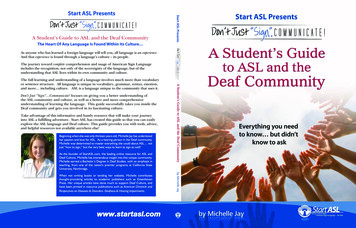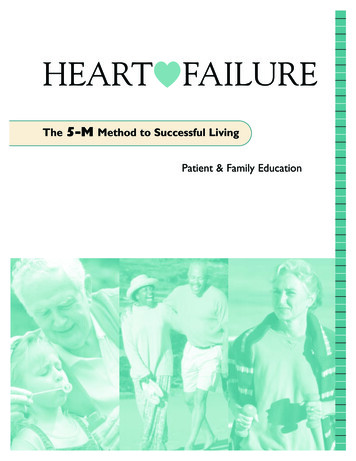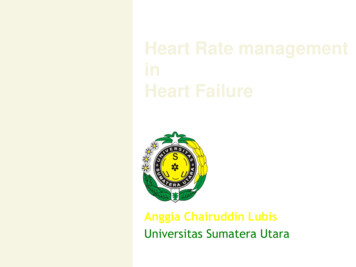
Transcription
A Student’s Guide to ASL and the Deaf CommunityThe Heart Of Any Language Is Found Within Its Culture As anyone who has learned a foreign language will tell you, all language is an experience.And that experience is found through a language’s culture – its people.The journey toward complete comprehension and usage of American Sign Languageincludes the recognition, not only of the sovereignty of the language, but of theunderstanding that ASL lives within its own community and culture.The full learning and understanding of a language involves much more than vocabularyor sentence structure. All language is unique in vocabulary, grammar, syntax, emotion,and more including culture. ASL is a language unique to the community that uses it.Don’t Just “Sign” Communicate! focuses on giving you a better understanding ofthe ASL community and culture, as well as a better and more comprehensiveunderstanding of learning the language. This guide successfully takes you inside theDeaf community and gets you involved in its fascinating culture.Take advantage of this informative and handy resource that will make your journeyinto ASL a fulfilling adventure. Start ASL has created this guide so that you can easilyexplore the ASL language and Deaf culture. This guide provides you with tools, advice,and helpful resources not available anywhere else!Beginning when she was only thirteen years old, Michelle Jay has understoodher passion and love for ASL. As a hearing person in the Deaf community,Michelle was determined to master everything she could about ASL notjust “how to sign,” but the very best ways to learn to sign as well!As the founder of StartASL.com, the leading online resource for ASL andDeaf Culture, Michelle has tremendous insight into this unique community.Michelle earned a Bachelor’s Degree in Deaf Studies, with an emphasis inteaching, from one of the nation’s premier programs at California StateUniversity, Northridge.When not writing books or tending her website, Michelle contributesthought-provoking articles to academic publishers such as GreenhavenPress. Her unique articles have done much to support Deaf Culture, andhave been printed in resource publications such as American Chronicle andPerspectives on Diseases & Disorders: Deafness & Hearing Impairments.
“This book is a real gem! Informative, intriguing, and an easy read -- it is your ticket to a new worldof friendships and cultural understanding! When it’s time to step out of the classroom and into theDeaf Community--Michelle Jay’s advice and insights are just what you need! Remember what youlearned from this book and you’ll do great!”William G. Vicars, Ed.D.Associate Professor of ASL and Deaf StudiesCalifornia State University, Sacramento(Also known as “Dr. Bill” of www.lifeprint.com)“Whenever I am questioned to offer a suggestion of a good, easy to read book about sign languageand the Deaf community, I now have a clear answer this book packs a ton of useful information inone spot. A must have for any new sign language student!”John Miller, Co-Founder, Educatorwww.signingsavvy.com“A Student’s Guide to ASL and the Deaf Community is an essential guide for those thinking oflearning ASL, considering a career working within the Deaf community or looking to understandDeaf culture. It truly is the bible for “everything you need to know but didn’t know to ask.” Thisbook is filled with all the important information you need in one place and is truly an amazingread.”Pearl Feder, L.C.S.W., Editor & CoordinatorSayWhatClub Social Mediawww.saywhatclub.com“For anyone interested in Deaf Culture, I recommend this book as a road map for joining it, fittingin, and finding a related career. Some of the resources outlined in the book are also useful for deafimmigrants to the USA.”Omer Zak, OwnerDEAF-INFOwww.zak.co.il/deaf-info“History and culture are an essential part of learning American Sign Language. In order for any ASLstudent to understand this complex and beautiful language, they must understand the very natureof those who use this language, the Deaf community. This is a great book for students to learn aboutthe Deaf Culture, community, history, professions and much more. I recommend this book as asupplement to any other ASL book used in the classroom.”Cindy Dawes, ASL InstructorFivay High School“As a Deaf person who hails from Gallaudet University with Masters Studies in ASL Linguistics,taught ASL at various state universities for over 25 years, trained sign language interpreters, andserved on the board for interpreter quality assurance qualification programs, I definitely suggestthis book for the beginning ASL signer. Communication involves so much more than just learning,using, and understanding the language. This book smoothly pulls it all together while inspiring thenovice learner. I whole-heartedly and with honor recommend this book.”MJ Williams, Author & Website Creator/Ownerwww.babiesandsignlanguage.com
ContentsContents 9Introduction 15How to Use This Book 17Understanding the Five Steps 17Useful Tools 18Checklist 18Tidbits 19Test Your Knowledge! 20Resources 20Who Should Use This Book 20Step 1: Start Learning American Sign Language 21The Top 5 American Sign Language Myths 21Myth #1: ASL is a signed version of English 22Myth #2: ASL is only capable of communicating concrete ideas 22Myth #3: ASL is a universal language 22Myth #4: Hearing people invented ASL 22Myth #5: ASL has always been seen as the official language of the Deaf in America 23The 7 Best Ways to Learn American Sign Language 23#1 - Interacting with the Deaf Community 24#2 - Taking an ASL Class 27Tips for taking an ASL class 28#3 - Learning from ASL Software 30#4 - Watching ASL Videos 31#5 - Studying ASL Textbooks 339
Don’t Just “Sign”. Communicate!#6 - Browsing ASL Websites 36#7 - Watching Deaf Vlogs 37Choosing How to Learn ASL 38Don’t Just “Sign”. Communicate!:A Student’s Guide to Mastering ASL Grammar 38Moving Forward 39Step 2: Learn About Deaf Culture 41The Deaf Community 41Introduction to Deaf Culture 42The Language of Deaf Culture 43The Values of Deaf Culture 43Language 43Not Speaking 43Socialization 44Literature 44The Rules for Behavior of Deaf Culture 47Labels 47Communication Strategies 47Introducing Yourself 49Name Signs 49Eye Contact 50Facial Expression 50Open Communication 50Deaf Culture Do’s and Don’ts 51Deaf People and Technology 53The Beliefs of Deaf Culture 54Beliefs about Being Deaf 54Beliefs about Deaf Educational Approaches 54Beliefs about Deaf Educational Learning Environments 55Beliefs about Cochlear Implants 5610
ContentsMembership in the Deaf World 57Deaf People Isolated in Hearing Society 58The Deaf Community 58Deaf Culture 59Deaf Ethnicity 60Learn More about Deaf Culture 60Moving Forward 63Step 3: Learn About Deaf History 65Introduction to Deaf History 65How Deaf Education Began 66American Sign Language 67The First College for the Deaf 68Oralism Versus Sign Language 69Learn More about Deaf History 71Moving Forward 73Step 4: Learn About ASL Careers 75ASL Interpreting 75Why become an ASL interpreter? 75Education and Experience 76Career Options 78Salary 79Resources 79ASL Teaching 83Why become an ASL teacher? 83Education 83Certification 84Career Options 84Salary 84Resources 8411
Don’t Just “Sign”. Communicate!Deaf Education 85Why become an educator of the deaf? 85Education 85Career Options 86Salary 87Resources 87Deaf Community Service 88Education 88Career Options 89Salary 89Resources 89Audiology 91Why become an audiologist? 91Education 91Licensing 92Career Options 92Salary 92Resources 93Speech-Language Pathology 93Why become a speech-language pathologist? 93Education 94Licensing 94Career Options 94Salary 94Resources 95Moving Forward 95Step 5: Learn the Terminology 97Deaf Community Terminology 97Moving Forward 114Final Chapter 115Test Your Knowledge! 11712
ContentsAnswer Key 125Resources 127Companies and Organizations 127ASL and Deaf Studies Websites 129American Sign Language 129The Deaf Community 130ASL Careers 130ASL and Deaf Studies Books 131American Sign Language 131ASL Interpreting 131ASL Teaching 132Audiology 132Deaf Culture and History 132Deaf Education 133Deaf Services 133Speech-Language Pathology 134ASL Videos 134ASL Software 135Movies 135Index 137About the Author 143Catalog 14413
STEP1Start LearningAmerican SignLanguageIn this section: The Top 5 American Sign Language Myths The 7 Best Ways To Learn American Sign Language Don’t Just “Sign”. Communicate!: A Student’s Guide to Mastering ASLGrammarThe first step when getting involved with ASL is to start learning the language.Notice that I am saying you only need to start learning American Sign Language.You do not need to know everything or be fluent in ASL in order to continue on tothe next steps.This section contains all of the information you truly need to know when you are learningAmerican Sign Language. There is a lot of information out there, but this section outlinesthe most important information you need to be aware of.After reading this section, you will know the truth about ASL, all the best ways to learn ASL,and where to learn the most important rules of ASL grammar. This section will save you alot of time and hours of research, so you can focus on the part of your journey that is themost fun—learning American Sign Language!The Top 5 American Sign Language MythsBefore learning ASL, it is very important that you know the truth about what you arelearning. In this section, I dispel five of the most common myths about American Sign21
Don’t Just “Sign”. Communicate!Language and the Deaf community. Knowing the truth about ASL will help you betterunderstand the language as you begin learning.Myth #1: ASL is a signed version of EnglishASL is not English at all. ASL is a distinct language with its own syntax and grammar. Youcan learn more about this in Don’t Just “Sign”. Communicate!: A Student’s Guide to MasteringASL Grammar, which I will be discussing later in this section.Myth #2: ASL is only capable of communicating concrete ideasIt is falsely believed that American Sign Language is only capable of communicating simple,concrete ideas. However, ASL, like any other language, is capable of communicating abstractand complex ideas. In ASL, you can discuss topics from theology and literature to sportsand shopping. ASL is capable of expressing poetry as well as humor and wit. There are nolimits to what can be expressed through American Sign Language.Myth #3: ASL is a universal languageASL is not a universal language. Deaf people around the world sign different languages justas hearing people around the world speak different languages. There are even regionaldifferences in the U.S.—signs can vary from state to state.FACTToday, there are at least 200 different forms of sign language in existenceworldwide.Myth #4: Hearing people invented ASLOne myth about American Sign Language is that it was invented by hearing people. Thisis false. Sign language in America has existed as long as there have been deaf people inthe U.S. Sign language is the natural language of deaf people, so they naturally create signlanguages in order to communicate.The standardized American Sign Language came about when Thomas Hopkins Gallaudetand Laurent Clerc founded the first school for the deaf in the United States. Deaf childrenfrom around the country came together for the first time, bringing along the signs theyused at home. Gallaudet and Clerc used these signs as well as signs from French SignLanguage to create a standard signed language to be used in the United States—American22
Step 1: Start Learning American Sign LanguageSign Language. The language was passed from generation to generation primarily inresidential schools*. The students spread the use of ASL throughout the U.S. and Canada.TERM*A residential school for the Deaf, “school for the deaf,” or “Deaf School” refers tothe type of school deaf children attend. They are an educational facility as well as ahousing facility for deaf students. Deaf adults who attended residential schools arevery proud of that fact.Myth #5: ASL has always been seen as the official language of the Deafin AmericaEven though American Sign Language is now seen as a natural method of communicationand education for the deaf, it wasn’t always this way. During the oralism movement in thelate 1800’s, most deaf educators discouraged the use of sign language in the classroom.They believed that deaf people needed to learn spoken language to fully function in thehearing world.However, sign language is and always will be the natural language of the deaf and thecenter of the Deaf community. During the oralism movement, deaf students continued touse sign language between classes and outside of school. Organizations that supportedthe use of sign language, like the National Association of the Deaf, were founded and theyfought against the belief that oralism was the only way. It wasn’t until 1960 when WilliamStokoe proved American Sign Language is a natural language that ASL was taken seriously.Oralism proved to be a failure for most deaf people, and American Sign Language waspopularly adopted into education once again.Many hearing people* falsely believe these five myths. Now that you know the truth aboutASL, you know what to expect as you begin.*Hearing people (or “Hearies”) are non-Deaf people. This term can refer specificallyto hearing people who are unfamiliar with Deaf Culture, but this term can alsoinclude all hearing people.TERMThe 7 Best Ways to Learn American Sign LanguageMost prospective ASL students do not know the best ways to learn ASL. And even if they doknow the best ways, many do not know how to access them. There are many different waysto learn ASL.23
Don’t Just “Sign”. Communicate!I will be sharing with you the best ways to learn. This information has never been explainedin this much detail before. Reading this section will save you time as well as make sure youare learning from the best resources out there.Which way you choose to learn ASL will depend mostly on your resources—where you live,how much money you can spend, and how much time you have. If you have an abundanceof these resources, I highly encourage you to learn ASL using all of these different ways. Themore ways you learn, the more well-rounded your language development will be.QUOTE“I think by far the best way to learn is socializing and using the language daily or asoften as possible. Some people find it hard to have contact with the language dailybut I just try to use all resources available to me.” - Jennifer Turner from South Florida#1 - Interacting with the Deaf CommunityThe best way to learn any language is from a native user. Here are 20 ways to meet, interact,and learn from Deaf people:1. Sign with Deaf friends. If you have any friends who are Deaf, this is a great place tostart. Your friend can give you private lessons or you can simply get together oftenand sign to each other. You can go over 10 new signs with your friend every time youget together.2. Attend Deaf Events. Deaf events are a great way to meet deaf people. Theseevents may consist of meeting at a coffee house, meeting up for ice cream,attending a fundraiser, etc. You can find Deaf events in your area on the OhSoEzwebsite. (www.ohsoez.com)3. Hire a Deaf babysitter. If you have a Deaf person frequently visiting your house,you can use it to your advantage. I’m sure the babysitter wouldn’t mind teachingyou (and maybe your children) some ASL. Every time you see him or her, you canlearn 10 new signs and practice them while you’re out! A good place to find a Deafbabysitter is at a Deaf school or a Deaf program in your area.4. Volunteer at a Deaf school or for a Deaf program. If there is a Deaf schoolor program in your area, get involved! You can learn ASL and give back to yourcommunity!5. Use a Deaf dating service. If you’re single, you can check into Deaf dating services.There are many available online—and I’ve heard this is a great way to meet Deafpeople.24
Step 1: Start Learning American Sign Language6. Find a Deaf club. Deaf clubs have always been a very popular place for Deaf peopleto socialize. If there are any in your area, I highly suggest checking them out.7. Start a sign language club. You can place a newspaper ad for anyone interested injoining your club. You may find a lot of hearing people who are interested and evensome Deaf people who would love to get involved.8. Hire a Deaf tutor. If there are Deaf tutors available to you, it would really be worthyour time and money to be tutored personally by a Deaf person. You will be amazedat how much you learn in a short amount of time when you communicate regularlywith a Deaf person.9. Attend Deaf plays/shows. Keep on the lookout for any local plays or shows put onby Deaf people. Some areas even have their own Deaf theaters. You can contact theNational Theatre of the Deaf to see if they are touring in your area.A good way to practice is to go on a “Deaf date”—go out with a friend and only useASL.TIP10. Attend interpreted shows/services. If you can’t find shows that are done by Deafpeople, you might be able to meet a few Deaf people by attending an interpretedplay, show, church service, etc.11. Volunteer at a Deaf Service Center. Deaf Service Centers are advocates for deafpeople and make sure they are always accommodated as required by law. Byvolunteering at one of these centers, you may be able to meet many Deaf people.12. Volunteer at a residential school. Residential schools are schools where deafchildren live and learn in a sign language environment. This is a great place to meetand interact with Deaf adults and children.13. Volunteer at a school with a mainstream program. A mainstream program is aprogram for deaf children at a public school. Using interpreters, deaf children areable to attend public schools with hearing children. This is a great place to meet andinteract with deaf children and interpreters.14. Mentor with an Interpreter. If you know any sign language interpreters, or haveany interpreting programs near you, you may be able to mentor with an interpreter.This is a great way to learn ASL from someone who is fluent, as well as meet andinteract with deaf people.25
Don’t Just “Sign”. Communicate!15. Attend deaf/interpreting related workshops. If you are lucky enough to haveany deaf-related or interpreting workshops in your area, attend them! Workshopsare very helpful and give you the ability to meet and interact with a variety of newpeople.16. Join RID. RID is the Registry of Interpreters for the Deaf. You can join as a supporter,attend events, and play an active role in the interpreting field.17. Join a sign language club at a local college or university. Colleges anduniversities have a variety of clubs. If there is a school near you, see if they have asign language club and join it. You can also read the “Sign Language Clubs” articleon About.com which lists some colleges and universities with sign language s.htm)18. Contact a local resource center for deaf and hard of hearing people. If you havea local resource center near you (check the Yellow Pages), you can contact them andprobably find out a lot of information about the Deaf community in your area.19. Contact a hearing and speech center. If you don’t know of any deaf centers,programs, or organizations, a hearing and speech center in your area may be able totell you where to find some.20. Attend a Silent Weekend. A Silent Weekend is a weekend where Deaf and hearingpeople get together and go on a weekend trip—where no voices are allowed. This isa great opportunity to completely immerse yourself in the language and culture ofthe Deaf. I highly suggest finding one of these trips to attend.“Classes can help some but immersing yourself in the environment is the best wayto become fluent in ASL.” – AnonymousQUOTEBasically, it doesn’t matter how you do it, you just need to meet and interact with Deaffriends. You don’t need to know Deaf people who can formally teach you ASL—justconversing with Deaf people on a regular basis will greatly improve your skills. This way,you are meeting new people, making friends, and forming bonds when entering into theDeaf community.However, I do know that not everyone lives near a Deaf community. There may not be anyDeaf people that live near you. If you have tried several ways to meet Deaf people and havenot met any, then try to work with what you have. Even though the best way to learn ASL isfrom conversing with Deaf people, there are other ways to learn as well.26
Step 1: Start Learning American Sign LanguageLearn with your family—get everyone signing!TIP#2 - Taking an ASL ClassAmerican Sign Language classes provide the interaction and reinforcement needed to buildyour confidence. Classes also offer opportunities to practice signing in real-life situations.Here are some ideas of where to find classes:1. Check your local colleges and universities. American Sign Language is nowrecognized as a foreign language and can be used to fulfill required foreignlanguage credit. ASL is accepted to satisfy the foreign language requirement inapproximately 180 four-year colleges and universities. And over 600 colleges anduniversities offer ASL classes. If there are any colleges or universities near you,contact them and see if they offer any formal ASL classes. If you need some help,Dr. Sherman Wilcox of New Mexico has compiled a list of “Universities That AcceptASL In Fulfillment Of Foreign Language Requirements” that is frequently updated.(web.mac.com/swilcox/UNM/univlist.html)2. Contact Deaf schools and programs. In many areas, the local Deaf schools andDeaf programs offer sign language classes. Many times, these classes are free.3. Contact local social service organizations. Social service organizations andinterpreting agencies are also known to offer sign language classes for the public.Check local speech and hearing centers as well as your state’s commission for deafand hard of hearing people for referrals.4. Find a community sign language class. You may be lucky enough to have acommunity sign language class near you. Public libraries and recreational programsfrequently offer sign language classes. Adult education course offerings usuallyinclude sign language classes.5. Check Info to Go. You can read the “Locating Sign Classes” publication on Info to Goto try to find classes. (clerccenter.gallaudet.edu/Clerc Center/Information andResources/Info To Go.html/locating-sign-classes.html)6. Find an online class. I know not everyone has access to formal in-person ASLclasses, which is the best kind of ASL class to take. So, I’m also suggesting onlineclasses. There are a few classes available online—both free and paid.27
Don’t Just “Sign”. Communicate!a. Free classes:i. Start ASL - (classes.startasl.com)ii. ASL University - (www.lifeprint.com)b. Paid classes:i. Signing Online - (www.signingonline.com)ii. Handspeak - (www.handspeak.com)7. Hire a tutor. I know it can get expensive to hire a sign language tutor, but if youdon’t have access to any other classes, this is a great way to learn.If you have difficulty finding a tutor, you can:a. Place an ad in the newspaper or in newsletters of social service agencies fordeaf people.b. Find tutors through databases:i. Language School Teachers - (www.language-school-teachers.com)ii. OhSoEZ - (www.ohsoez.com)c. Find tutors through tutor websites:i. Hardcore ASL - (www.hardcoreasl.com/tutoring.html)ii. Cathy’s ASL Services - (www.cathysaslservices.com)8. If you can’t afford a certain class, you can volunteer to help the instructor. Youcan offer to be a teaching assistant, run errands, grade papers, babysit, give theinstructor a ride to class, be a substitute, or whatever else you can come up with. Ifyou make yourself available to the instructor, they may let you sit in on their classesfor free.Tips for taking an ASL classIf you do find an ASL class near you, here are some tips on how to get the most out of the class.1. Don’t miss class. It is very important for you to attend class--especially at thebeginning of the term. This is because a sign language class is meant to be a veryinteractive environment. It’s much easier to feel comfortable enough to interactwhen you get to know all the students you will be learning with.28
Step 1: Start Learning American Sign Language2. Arrive early. Being early for class gives you a chance to practice and engage insigned conversations before class begins. If you arrive late, it is expected in Deafculture that you briefly explain why you’re late when you enter the classroom. Justwalk in, wait for your instructor’s attention, briefly explain, and be seated.3. Watch the signer’s face, not their hands. You will understand a lot more of what yousee this way. Make sure you don’t break eye contact--just use your peripheral vision.4. Don’t talk in class. Unless your instructor asks you to use your voice, which iscalled “voicing”, stay quiet. If a classmate is struggling to learn something, resist thetemptation to voice an English translation. If all else fails, your instructor will writeit on the board. Make sure to keep up this signing environment before class, afterclass, during breaks, and whenever you are around Deaf people.5. Participate. The more you participate in class, the more you learn. You shouldbe communicating often and following as many signed conversations in class asyou can—between your instructor and your class, between your instructor and astudent, or between students.6. Don’t worry about making mistakes. You will make plenty of mistakes, and so willeveryone else in your class. Mistakes are part of learning.7. Always pay attention to your instructor. If your instructor needs your attention,he or she will notice immediately if someone breaks eye contact. If you break eyecontact, your instructor will stop, wait to get your attention, ask what you missed,and then repeat it for you while the rest of the class waits. Eye contact is veryimportant, so if you need to take notes, try to learn how to do so without looking atyour paper.8. Let your instructor know immediately when you don’t understand. All you haveto do is get your instructor’s attention and sign DON’T-UNDERSTAND. This behavioris expected, so don’t be afraid to use this sign often.9. Don’t say you understand if you really don’t. If your instructor asks if youunderstand something, don’t lie. Deaf instructors can normally tell by your bodylanguage and facial expression that you don’t understand. Letting the instructormove on without understanding something can lead to more confusion later on.10. Use the signs you learn from your instructor. You will probably learn a varietyof ways to sign certain words. This is because different regions sign some wordsdifferently. Just ask your instructor and sign the word the way he or she signs it.29
Don’t Just “Sign”. Communicate!ASL classes are a great way to learn American Sign Language. A lot of times, you will get aDeaf instructor and be able to learn ASL from a native signer. Most classes also attend Deafevents to practice their skills. This will give you both the classroom attention and Deafcommunity interaction that you need.Next to learning ASL directly from conversing with Deaf people, ASL classes are the nextbest way to learn. However, I do know that not everyone has access to ASL classes. If youhave not been able to find any classes near you, then try to work with what you have. Eventhough the best ways to learn ASL are by conversing with Deaf people and taking an ASLclass, there are other ways to learn as well.#3 - Learning from ASL SoftwareUnlike learning from Deaf people or in a formal class, computer software doesn’t providefeedback. However, if you don’t have access to better resources, this is a good choice.Here are some software programs that I recommend:The Start ASL Offline PackageThe Start ASL online classes are available as instant downloads.These files contain all of the ASL 1, 2, & 3 class Lessons, Readings,Videos, and Workbooks. I highly recommend this package for ASLsoftware. While it doesn’t include ASL vocabulary videos, it doesteach ASL grammar. You also have the advantage of having accessto the same classes online, so you can take the classes with youwherever you need to go. (offline.startasl.com)Rocket American Sign LanguageThe quality of this software is great, the games are fun, and it’savailable in an instant download (no waiting for shipping andloading CDs into your computer). This is a good program if youare just starting out. The quizzes are a bit easy if you alreadyknow a lot of ASL vocabulary.QuickStart American Sign LanguageI have heard great things about this software. It’s great forbeginners and is very affordable.30
Like what you read? These Student Guides Will Teach You: Information to help you successfully learn ASL, syntax, grammar and more.Deaf community information that is essential to those learning American Sign Language.The proper terminology within the Deaf community.Essential information about where your ASL knowledge can take you.Inspirational stories to give you an intimate look into the deaf and hard of hearing community.And so much more!
A Student's Guide to ASL and the Deaf Community The Heart Of Any Language Is Found Within Its Culture As anyone who has learned a foreign language will tell you, all language is an experience. And that experience is found through a language's culture - its people. The journey toward complete comprehension and usage of American Sign Language .










